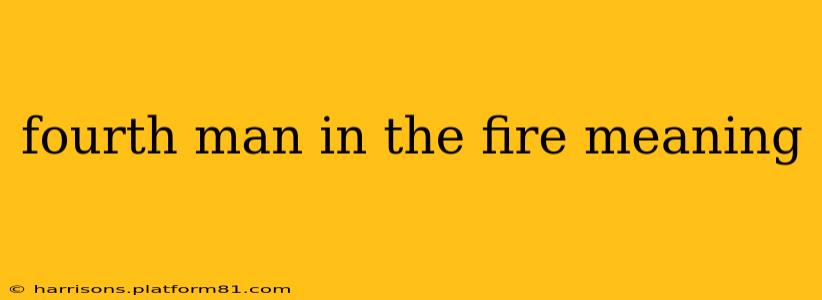The phrase "fourth man in the fire" originates from the Book of Daniel in the Bible (Daniel 3:25). It describes the miraculous deliverance of Shadrach, Meshach, and Abednego from a fiery furnace. While the literal meaning speaks of a divine rescue from imminent danger, the phrase's symbolic meaning resonates far beyond the biblical narrative, holding profound significance for faith, resilience, and the unseen forces that shape our lives.
This article will delve into the multiple interpretations and meanings of "fourth man in the fire," exploring its significance across various contexts and addressing common questions surrounding this powerful image.
What Does "Fourth Man in the Fire" Symbolize?
The "fourth man" is generally interpreted as an angelic being, a manifestation of God's presence, or a representation of divine protection. He walks with the three Hebrew men in the furnace, untouched by the flames, highlighting the power of faith and God's unwavering support in the face of seemingly insurmountable odds. Therefore, the symbolism extends to:
- Divine intervention and protection: The fourth man represents God's direct involvement in protecting the faithful, even amidst extreme adversity. It suggests that there's a force greater than ourselves that can shield us from harm and guide us through difficult times.
- Faith and resilience in the face of adversity: The story emphasizes the unwavering faith of Shadrach, Meshach, and Abednego. Their steadfastness in their beliefs, even when faced with death, embodies resilience and the power of conviction. The fourth man underscores the reward for such unwavering faith.
- Hope and the presence of the unseen: The "fourth man" symbolizes hope and the presence of something beyond our immediate perception. It suggests that even in the darkest moments, there is a source of strength and comfort that we may not always see but can feel.
- Community and shared faith: While the focus is often on the individual experience of faith, the presence of the three men together highlights the strength of shared faith and community in overcoming challenges.
Who is the Fourth Man in the Fire?
The biblical text doesn't explicitly identify the fourth man. However, various interpretations exist, including:
- An angel: This is the most common interpretation, suggesting a divine messenger sent to protect the three men.
- Jesus Christ: Some Christian interpretations identify the fourth man as a pre-incarnate appearance of Jesus Christ, foreshadowing his future role as savior.
- The Holy Spirit: Another interpretation sees the fourth man as the Holy Spirit, the divine presence that empowers and sustains believers.
- God himself: Some see the fourth man as a direct manifestation of God's presence, emphasizing the immanence of God in human affairs.
What Does the Fourth Man in the Fire Mean in Modern Contexts?
The phrase "fourth man in the fire" has transcended its biblical origins and now serves as a potent metaphor in modern contexts. It speaks to:
- Overcoming personal challenges: The story inspires individuals to persevere through difficult personal situations, knowing that there might be unseen support guiding them through the trials.
- Finding strength in faith and community: The image reminds us of the importance of faith, both personal and communal, in finding strength and resilience amidst adversity.
- Embracing hope and perseverance: Even when facing overwhelming odds, the "fourth man" symbolizes the enduring power of hope and the importance of persevering in the face of difficulty.
Is There a Spiritual Meaning to the Fourth Man in the Fire?
Yes, the spiritual meaning of the fourth man is profound. It points to a transcendent power that offers comfort, protection, and guidance, particularly in times of profound suffering and uncertainty. It's a symbol of divine intervention, unwavering faith, and the enduring strength that can be found in believing in something larger than oneself.
The story of Shadrach, Meshach, and Abednego, and the mysterious fourth man in the fire, remains a powerful and enduring symbol of faith, resilience, and the possibility of divine intervention in the face of adversity. Its meaning continues to resonate across cultures and generations, offering hope and inspiration to those who face their own fiery trials.
